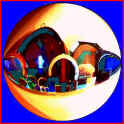

![]()
Thin Film Coating:
There are several ways to create a thin film coating . The most popular is called E Beam Evaporation.
Thin film or dichroic coatings by HD DICHROIC™ are manufactured by a process known as Electron Bombardment Evaporation or E Beam Evaporation.
Glass substrates are placed on rotation disks which spin in a planetary direction inside of a large thermal controlled vacuum chamber . At the base of the vacuum chamber there is a rotating multi crucible where minerals are loaded, below the crucible is a source used to heat and evaporate the minerals .
In a thermal vacuum environment the minerals become an inherent part of the substrate. This process is achieved without opening the chamber. Monitoring is done by passing lightwaves to a blank monitor substrate, reflected light is detected by using a photomultiplier, then we calculate the mathematical and size allowances of the vacuum chamber. As each mineral layer is deposited on the monitor blank the reflected light oscillates in a simulated sine wave which allows us to determine the layer thickness required to match the desired wavelength curve .
With thermal and vacuum conditions control we are able to produce an extremely durable coating that resists heat, thermal shock and abrasion.
Production and control is a major factor in regard to the quality of the dichroic color filter you are purchasing. First you must have a design team capable of producing a product to meet your application. HD DICHROIC™ employs optical design engineers qualified in MIL spec. coating applications while using the latest computer technology available. Layering and substrate masking can make a big difference in regards to the consistency of the end product. Controlled and clean environment in all coating procedures are a must. Substrate cleaning and handling is always a consideration, tits produced by dirt and scratches can weaken the coating. There are several minerals that can be used to produce the same color, some minerals are less in cost this can effect the hardness of a coating . Post coating processes can also differ.
Dichroics and how they work:
There are four types of color filters used to produce colored light. Dyed polyester, tinted or resin coated glass and Dichroic coatings on glass.
Polyester type holds up well for short term applications, but in time they fade, the same is true with tinted glass. Resin dipped or coated glass tend to flake and crack.
The problem with dyed polyester, glass and resin coatings is that the wavelengths of the light spectrum which does not pass through the filter are being absorbed by the filter, thus breaking down the organic dyes used for the color. The filter becomes dull and lifeless.
Vacuum coated minerals on glass is the key. We fabricate a mirror like lens which reflects certain wavelengths of light while transmitting the selected wavelengths we require to achieve the desired color filter. This is known as the dichroic or band pass color filter.
For Example:
A blue transmitting dichroic transmits the blue while reflecting the yellow. A red transmitting dichroic transmits red while reflecting green and blue. The end result is extremely steep color separation that could never be reproduced with organic dyed substrates.
Off axis tweaking:
In the process of creating a color separation mirror we are also able to tweak or pivot the mirror off of a O° axis and create other colors.
For Example:
When tweaking a dark blue dichroic at approximately 22° we get a lavender, tweak to 80° you get a flesh pink. With a light red at 22° you get a rich amber, go to 80° you get a bright yellow.
We can also produce color and white light by adding and subtracting light with dichroic filters.
A total of five filters would be used. Additive colors (1) Red, (1) Blue, and (1) Green. Each additive filter to have a source of its own at 0°. Subtractive colors would be (1) Blue reflector at 45° and (1) Magenta reflector at 45°. NOTE: The Blue reflector equals a Yellow filter at 0° and the Magenta reflector equals a Green filter at 0°.
Long wave separation filters:
Cold mirror filters reflect the visible light at a specified incidence of angle while transmitting the heat or infrared lightwaves to an area not effected. Normally from 45° as a bounce to a ellipsoidal reflector of 180° where the heat is passed through the back of the reflector.
Hot mirror filters work in the opposite normally 0° transmitting the visible lightwaves rejecting the infrared back to the source. The Hot mirror can also be directed up to 22° to reject the heat in another direction for fixture cooling.
![]()
![]()
![]()
"Fun With HD Dichroic™ Color Filters, Ultraviolet Blacklite™ and
HD*VR™ Multimedia Eyewear".
